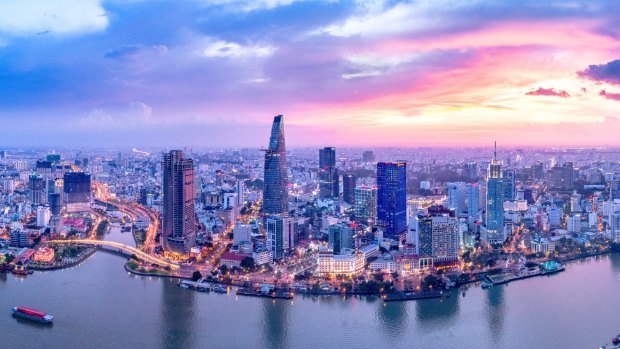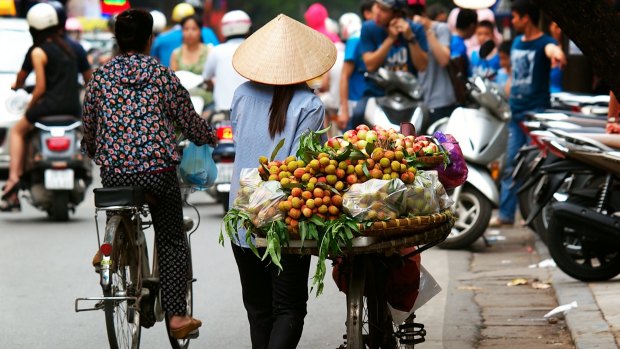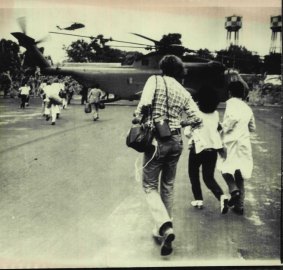This was published 5 years ago
Ho Chi Minh City, Vietnam: Exploring Saigon's recent history is fascinating but intense

The Ho Chi Minh City skyline and Saigon River.Credit: Shutterstock
With my back to the cathedral and the colonial yellow post office to my left I can see the old apartment block directly ahead, overshadowed these days by skyscrapers. On April 29, 1975, as Saigon fell to the communist forces from the north, Southern Vietnamese and US nationals attempting to flee the city queued on a ladder to the building's roof where a small helicopter was perched. A Dutch photojournalist captured the event at the time.
"Take a photograph of it because it won't be there for long," war historian, author and occasional tour guide Jimmy Thomson advised before I left Australia for Vietnam. He also told me about a secret passageway in a palace, new war museum exhibits and hotels formerly popular with military and press. Exposure to these and other wartime remnants, reminders and ghosts in and near Saigon broadened my understanding (if war can be understood) of a significant piece of recent history I'd only ever looked at through Australian and Hollywood lenses. For starters, not everyone calls it the Vietnam War; in Vietnam, it's the American War or Anti-American War.
In 1975, Saigon was renamed in honour of communist revolutionary leader Ho Chi Minh but both names are in use. Our guide for the day is a university and music student who tells us straight up that she's a communist. The war was well over by the time Ly (not her real name) was born but her mother and aunt were Viet Cong or, as preferred, Viet Minh. Ly's aunt was killed by a bomb.

Street vendor in Saigon. Credit: Shutterstock
After stopping to look at the outside of Notre-Dame Basilica and the inside of Saigon Central Post Office, we minibus to Cu Chi district. Freedom fighters started building tunnels in the stable soil beneath the jungle upriver of Saigon during the 1940s when the French still occupied the country. During the Vietnam War these were extended into a complex network of about 250 kilometres at various depths, linking 16,000 people from six villages.
At Cu Chi Tunnels we watch demonstrations of how Viet Cong fighters camouflaged themselves in tiny underground hideouts and recycled tyres into shoes designed so they could fit back-to-front and disguise a walker's direction. A short section of tunnel, made higher and wider for tourists, triggers my claustrophobia. Revolutionaries used to crawl on their bellies through dark tunnels up to 10 metres below the surface, avoiding their own traps. They often lived underground for months at a time. A troop of Australian sappers explored the tunnels mid-conflict.
Back in the fresh air some British tourists are climbing on a tank and cracking jokes. For an extra fee you can shoot an AK47 or M16 though Ly doesn't recommend it. During her military service they tried to teach her to shoot. "I don't like gun. I fail," she says. The Cu Chi tour finishes with a historic film in which young female and male guerrillas are called "American killer heroes".

Americans and Vietnamese run for a US Marine helicopter during the evacuation of Saigon Tuesday. April 29, 1975. Credit: AP Radiophoto
We return to the city for the War Remnants Museum. With a sticker of a white dove flying ahead of rocket missiles stuck to my chest I shake the stump of a local man who has lost his forearm, and enter a courtyard packed with American armaments. There's a tank, Chinook, 40-tonne bulldozer, self-propelled 175mm gun, Douglas A-1 Skyraider.
"I used to build all these things from a kit as a boy," an older man on my tour says, his eyes alight with enthusiasm.
In the newly installed torture exhibit, outside the main building, a couple of us get chatting to Peter from the US who walks with a stick and is in Vietnam for the first time since being drafted. He's accompanied by his Vietnam-born wife, Elsa, and her sister. He, too, has just arrived at the museum but already some wording on a sign – the Aggression War Against Vietnam – is bothering him. Peter says that's not how he remembers it.
Inside the main building are rooms with names such as Historic Truths and Requiem. There's also Agent Orange Consequences through Children's Paintings.
On the second floor is a space in which you're supposed to remain quiet where the display is photojournalistic images from 1955 to 1975 with no apparent content censorship. To call this exhibit sobering is like suggesting heroin is soothing. When Jimmy was there a Korean man walked out of the room, put his face in his hands and howled. The guy who'd got excited by the US military equipment downstairs looked at the first few images on the wall – one is of children cowering at gunpoint beside such machinery – and immediately deleted all his courtyard shots.
The rest of my group fly out that evening but I stay on. I check out the Caravelle Hotel – its now flashy rooftop bar was a favourite watering hole for international media. A bomb exploded on its fifth floor in 1964 but journalists were all out in the field at the time. The nearby Rex Hotel, where the US military held press briefings code-named five o'clock follies, has a rooftop bar, too, with a band playing Carpenters covers and is also no longer evocative of wartime.
I spend the next morning at the Presidential, or Reunification, Palace where the gates were flattened by tanks when Saigon fell. Jimmy had mentioned "the president's office has a secret passageway that takes you all the way down to the bunkers" where there are tunnels wide enough to drive a car through to the river. But the passageway door is locked and the security guard won't budge.
It's time for a break anyway so I head to the retro calm of Compass Cafe whose co-owner, Mark Bowyer, wants the shooting range at Cu Chi shut down. Over lunch I flick through photographs in Ten Years After; Vietnam Today that depict recovery through recycling – every American bombshell casing, it seems, was repurposed.
The cafe's other owner, Dang Thuy Duong, arrives while I'm there and we talk for a while. She was born in 1979 in the north but raised in the south with a father in the air force. She feels "the whole country has moved on but I think it's important to remember and understand the past". Duong considers the War Remnants Museum a must for everyone who visits, including all Vietnamese people, but also understands "some people can't go there".
Before we left the museum the previous day someone in my group spotted Peter again. He was upstairs gasping and crying at images of Agent Orange victims – not historic photos but ones taken only recently. Up to a million Vietnamese adults and children are currently disabled or sick from exposure to the chemical used excessively by the US throughout the '60s to poison crops and defoliate jungle. Some international soldiers, including Americans, were also contaminated. It remains in Vietnam's eco-system and continues to cause severe birth defects.
Ly, obviously used to shell-shocked tourists, was waiting for us outside. "I know in the museum you have many emotions and you understand more the war," she'd said in the privacy of the minibus. "I don't want to say who was wrong and right. Nobody right or wrong."
Ly told us local people have become more open-minded because so many US veterans have returned and apologised. As a guide, Ly has spoken with enough of them for her own perspective to shift – though added "we don't smile because we forgot but because we've forgiven". Nowadays it's not the Americans they don't like but the backpackers. And "K-pop has invaded".
Elspeth Callender travelled as a guest of Webjet Exclusives.
FINDING RESPITE FROM WAR THEMES IN SAIGON
GET HIGH
Take the elevator up one of Vietnam's tallest buildings to Saigon Skydeck for a 360-degree view of the city. Two floors above is Eon 51 Heli Bar for food, drinks and live music. See bitexcofinancialtower.com and eon51.com
TAKE A FAST FOOD TOUR
Jump on the back of a scooter with a local and zip around the city for the evening, stopping off at five interesting locations, to get a real taste of Saigon's street food culture. See backofthebiketours.com
LEARN TO COOK
Take a cooking class under the instruction of a local chef from Hoa Tuc restaurant. Combine a market tour with a class and gather ingredients beforehand to really improve your understanding of Vietnamese cuisine. See saigoncookingclass.com; hoatuc.com
SEE TO THOSE NAILS
There are manicure and pedicure joints throughout the city and many are open extremely late. The highest concentration is in the Pham Ngu Lao ward of district 1 near Ben Thanh Market.
CHILL OUT
Get your hipster fix at Saigon Outcast in district 2 where converted shipping containers are artfully graffitied. It's a great place for lunch and an IPA, plus there are evening films and concerts over summer. See saigonoutcast.com
TRIP NOTES
MORE
TOUR
Webjet Exclusives offers a range of Vietnam tours, including nine-, 10- and 16-day itineraries departing Sydney and Melbourne, with airfares and accommodation included, from $999 per person twin share. See exclusives.webjet.com.au
READ
Jimmy Thomson has written two books about Australians in the Vietnam War – Tunnel Rats and A Sapper's War – and his next crime novel, Tunnel Vision (Affirm Press), is set mostly in Saigon. See jimmythomson.com
Sign up for the Traveller Deals newsletter
Get exclusive travel deals delivered straight to your inbox. Sign up now.